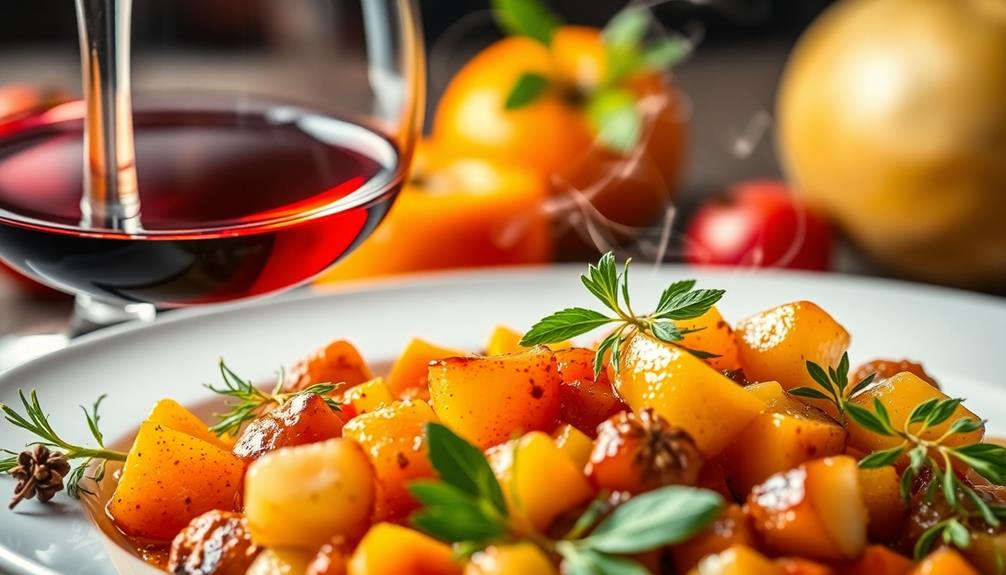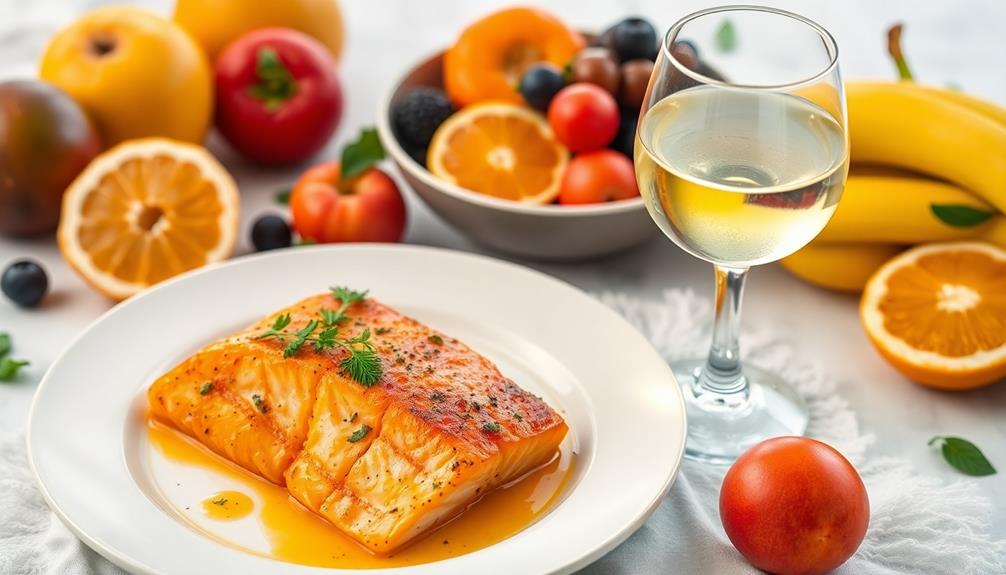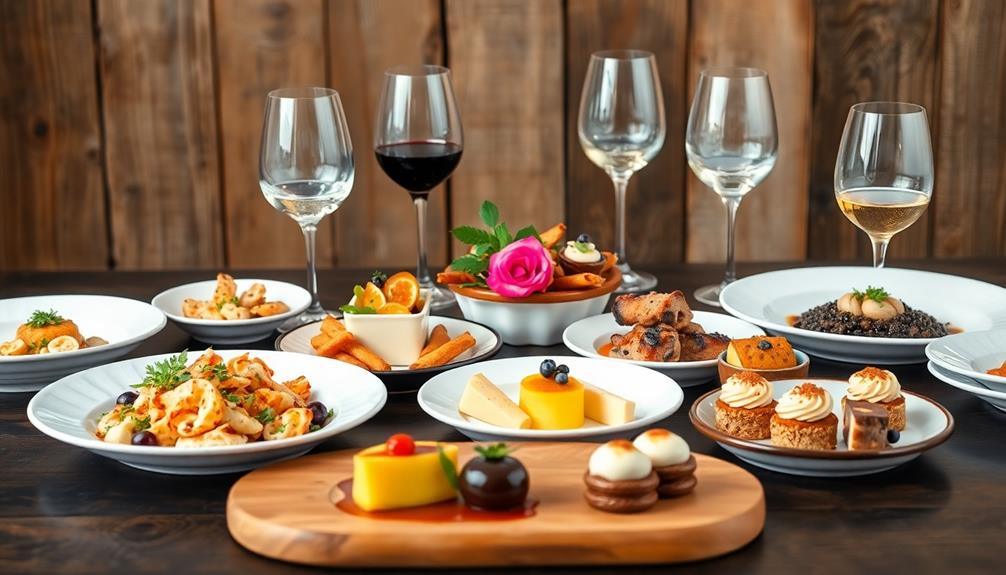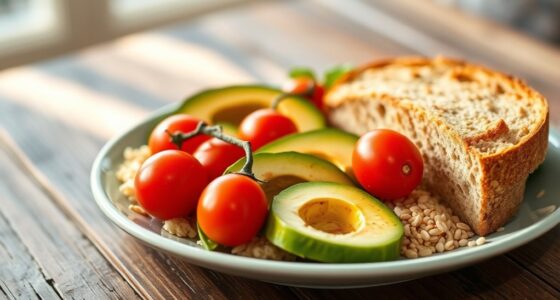The science of perfect food and wine pairing is all about creating a beautiful balance of flavors and aromas. You need to reflect on the five primary tastes: salty, sweet, umami, bitter, and sour. High-acidity wines work well with fatty or spicy dishes, while tannins suit rich proteins. Matching the weight of the wine to the food's body adds harmony, and experimenting with contrasts can reveal unique combinations. Remember, pairing isn't just about rules; it's about personal preferences too. There's so much more to explore in achieving the ultimate dining experience.
Key Takeaways
- Understanding primary tastes and aroma enhances the overall flavor experience, impacting food and wine pairings.
- High-acidity wines balance rich dishes and complement spicy foods, enhancing the dining experience.
- Matching the body and weight of wine with food creates harmonious pairings for better flavor synergy.
- Sweet wines can offset spiciness and enhance the enjoyment of diverse cuisines, including cheese pairings.
- Experimentation with traditional pairing rules allows for personalized and adventurous flavor combinations.
Understanding Taste and Aroma

When you savor a meal or sip a glass of wine, you're not just experiencing taste—you're engaging with a complex interplay of flavors and aromas. The perception of taste hinges on five primary tastes: salt, sweet, umami, bitter, and sour. However, aroma greatly enhances your overall flavor experience.
Certain dishes, like Red-Braised Pork Belly, with their rich flavors, can harmonize beautifully with specific wines, creating a memorable dining experience. You can detect around 10,000 different aromas, and these interact with your taste buds to create a rich flavor profile.
As you chew, the retronasal passage connects your mouth to the olfactory bulb, allowing aromas to influence your perception of taste. This connection means that the aroma compounds in wine can trigger brain responses, heightening your anticipation and enjoyment of flavors.
For instance, high acidity in a wine can complement the sweetness in a dish, creating an ideal food and wine pairing.
Moreover, positive associations linked to specific smells can profoundly affect your enjoyment of what you're consuming. By understanding how taste and aroma work together, you can elevate your dining experiences, discovering new pairings that delight your senses and deepen your appreciation for the culinary arts.
Key Wine Characteristics

Understanding key wine characteristics is essential for crafting perfect food pairings. By recognizing these traits, you can guarantee a harmonious balance between your wine and food. The body of the wine—whether it's light, medium, or full-bodied—should match the weight of the dish. For instance, a full-bodied red pairs beautifully with hearty meats.
| Wine Characteristic | Description |
|---|---|
| Acidity in Wine | Balances flavors, ideal with fatty or high-acid foods. |
| Tannins | Found in red wines; astringent, great with high-protein dishes. |
| Body of the Wine | Light, medium, or full-bodied; matches food weight. |
| Alcohol Content | Influences weight and flavor intensity, affecting pairings. |
Aromatic compounds in wine—ranging from fruity to herbal—enhance your dining experience by complementing or contrasting with your meal's aromas. For instance, a high-acid white can brighten a rich dish, while tannins in red wines can elevate the experience when paired with steak. By focusing on these wine characteristics, you'll elevate your food-wine pairing game and impress your guests.
Principles of Pairing

Crafting the perfect food and wine pairing involves more than just selecting a bottle to complement your meal; it's about applying key principles that enhance the overall experience.
Understanding the science behind these pairings can elevate your dining occasions. For example, when hosting a Halloween gathering, contemplate how a spooky drink option like Bloody Shirley Temples can set the mood while harmonizing with your food choices.
Here are three essential principles to contemplate:
- Weight Matching: Align the weight of the wine with the weight of the food. Robust dishes pair well with full-bodied red wines, while lighter meals benefit from crisp white wines.
- Acidity Balance: High acidity wines, like Sauvignon Blanc, work beautifully with acidic foods. Pairing them with citrus salads creates a delightful synergy that enhances both flavors.
- Flavor Complementation: Look for complementing flavors. Fruity wines can enhance desserts, while sweet wines, such as Riesling, counteract the heat in spicy dishes, creating a balanced and enjoyable tasting experience.
Recommended Food Pairings

Food pairings can transform a meal into a memorable experience, and knowing which wines to choose can elevate your dining pleasure. The right combinations enhance flavors and create a delightful balance that excites your palate. Here are some recommended pairings to take into account:
| Food | Wine Pairing |
|---|---|
| Italian dishes (e.g., tomato sauce) | Sangiovese (red wine) |
| Delicate seafood | Light white wine |
| Spicy foods | High-acid wine (Sauvignon Blanc) |
| Aged Manchego cheese | Full-bodied red wine |
| Gorgonzola cheese | Sweet wines |
Each wine's unique components play an essential role in pairing with food. For instance, the acidity in Sangiovese complements the acidity in tomatoes, creating a harmonious flavor profile. High-acid wines work wonders with spicy dishes, soothing the heat while enhancing flavors. Enjoying aged Manchego with full-bodied red wines cuts through the cheese's creaminess, revealing its nutty notes. Embrace the Science of Food and let these pairings guide you to a memorable dining experience.
Exploring Wine and Cheese

When you think about the perfect pairing, wine and cheese often come to mind as a classic combination that can elevate any gathering.
The key to a successful pairing lies in understanding the characteristics of both the wines and the cheese. For an adventurous twist, consider incorporating elements of Japanese cuisine like Umeboshi, which can add a unique flavor profile to your cheese board.
Here are three essential tips to enhance your tasting experience:
- Match Texture: Creamy cheeses like Brie or Camembert pair wonderfully with crisp white wines, as the wine's acidity complements the cheese's richness.
- Contrast Flavors: Sweet wines, such as Port or Sauternes, balance the saltiness of blue cheeses like Gorgonzola, creating a delightful flavor contrast.
- Align Intensity: Aged cheeses like Manchego go well with full-bodied red wines, as their robust flavors can stand up to the wine's tannins.
Strategies for Successful Pairing

Successfully pairing wine with food often involves understanding how different elements interact on your palate. One effective strategy is to match the body and weight of the wine with your dish. For instance, when you're enjoying high-acid foods, a crisp white wine like New Zealand Sauvignon Blanc goes perfectly, as it cuts through richness and enhances palate cleansing. This creates a harmonious experience without overwhelming your taste buds.
Additionally, when savoring dishes like Caldeirada, a rich fish stew, a light-bodied white wine can complement the seafood beautifully.
Another approach is to focus on complementary flavors. Fruity wines pair delightfully with fruity desserts, while earthy wines like Pinot Noir elevate dishes featuring mushrooms. These successful food and wine pairings enhance your overall dining experience by creating balance.
Don't hesitate to experiment! Traditional rules can guide you, but personal preferences vary. For example, sweet wines like Riesling or Moscato beautifully complement spicy foods, helping to balance heat and soothe palate irritation.
Balancing Acidity and Sweetness

Balancing acidity and sweetness in wine can elevate your dining experience considerably. Understanding the interplay between these elements is essential for creating harmonious food pairings.
For example, a high-acidity wine can beautifully complement a rich dish like braised beef in Barolo wine, as the acidity cuts through the fat and enhances the overall flavor. High-acidity wines are fantastic companions for fatty foods, as they cleanse the palate and help balance richness.
On the other hand, wines with sweetness can offset spicy dishes, providing a soothing effect that enhances flavor.
Here are three key considerations for achieving balance:
- Acidity vs. Sweetness: High acidity works well with rich, creamy dishes, while sweeter wines pair best with equally sweet or flavored foods.
- Residual Sugar Levels: Choose wines with higher residual sugar for sweeter dishes to maintain flavor integrity, preventing the wine from overpowering the meal.
- Low-Acid Pairings: Low-acid wines shine when complemented by creamy sauces or mild, fruity foods, enhancing their overall flavor perception.
Practical Pairing Examples

Often, the right wine pairing can elevate a meal from ordinary to extraordinary. For instance, if you're enjoying fried green tomatoes, consider a crisp Chardonnay. The acid in the wine cuts through the dish's richness, creating a delightful contrast.
If you're having a lamb slider, a young Cabernet Sauvignon makes a great match, as its tannins balance the meat's fat content. When indulging in hearty Mexican dishes like Chilaquiles, a revitalizing Sauvignon Blanc can complement the bright salsa and creamy toppings beautifully.
When it comes to arancini, a Merlot mightn't be the best choice. The mildness of the dish can overshadow the wine's flavors, showing how important it's to match intensity in pairing food and wines.
If you're in the mood for something spicy, sweet wines can be your secret weapon. Their sweetness soothes palate irritation, enhancing your overall dining experience.
For a classic pairing, try Sangiovese with bolognese sauce. The wine's acidity beautifully cuts through the meat's richness while complementing the tomato base.
Frequently Asked Questions
What Makes a Good Food and Wine Pairing?
A good food and wine pairing balances flavors and textures. You'll want to match the wine's body with the food's weight, consider acidity, and guarantee the sweetness complements the dish for a delightful experience.
What Is the Rule #1 When Matching Food With Wine?
"Birds of a feather flock together." When matching food with wine, you want the wine's body to match the weight of the dish. Full-bodied wines pair with robust meals, while lighter wines complement delicate flavors.
How Do You Choose the Best Food and Wine Pairings?
To choose the best food and wine pairings, consider the weight of the dish and wine, acidity levels, and complementary flavors. Don't hesitate to experiment with contrasting tastes for a more exciting culinary experience.
What Are the 6 Elements of Wine and Food Matching to Be Considered?
When matching food and wine, you should consider body matching, acidity levels, tannins and proteins, flavor intensity, sweetness, and spice. Each element plays a crucial role in creating a harmonious dining experience. When these factors are in balance, they enhance the flavors of both the dish and the wine, elevating the overall meal. Considering food synergy and nutrition combinations can further enrich the experience, as certain pairings not only taste exceptional but also optimize nutrient absorption. Thoughtful pairings bring out the best in each component, creating a delightful and memorable culinary journey.
Conclusion
You might think food and wine pairing is all about strict rules, but it's really about exploration and enjoyment. Trust your palate and don't hesitate to experiment—some of the best combinations come from unexpected matches. Picture yourself savoring a rich, creamy Brie paired with a crisp Sauvignon Blanc, the flavors dancing together in perfect harmony. Embrace the adventure of pairing, and you'll discover a world of delightful experiences that elevate every meal. Cheers to your culinary journey!










